Up in the Hills
Two Caves and a Fort
(Dec. 12-14, 2003)
 |
|
The line of 3-wheeler auto-rickshaws waiting for us. |
Lonavla and its sister town Khandala are about two and a half hours by train from Bombay. They are hill stations, where the British used to escape for a trip to the coolness of the higher altitudes and the pleasant scenery of the mountains and valleys. So, what does “hill station” conjure up for you – a bit of the Raj, like an English village in the Lake district? Or, perhaps the image of an alpine retreat, neat little towns away from the hubbub of the city? That is not what we found, but we discovered wonders all the same.
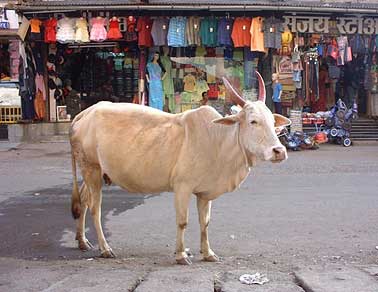 |
|
Pavement dweller on the village street. |
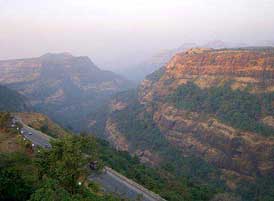 |
|
The view from the dining room. |
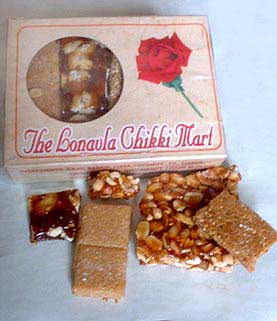 |
|
Chikki, the local peanut brittle-like candy. |
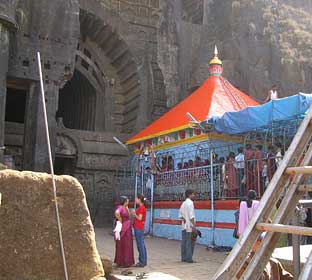 |
|
The primary attraction for most visitors is not the Buddhist cave temple, but the more recent Hindu temple. |
On Saturday morning, our first stop was at the Karla temple. This cave holds an additional attraction: at the same site is a more recent Hindu temple, which is the primary attraction for most visitors to this place. The taxi dropped us at the parking lot, and we started our ascent with the pilgrims bound for the Hindu temple – we were promised 250 steps to the top, but these were very long steps. The edges of the steps were lined with an array of activities – stalls selling figures and pictures of the goddess in the temple or flowers to bring along to the temple. Single vendors selling berries in a newspaper cone or some sort of frothy lime-ade. Beggars asking for baksheesh (a donation to their cause). We passed a woman on the descent, carried in a chair by four porters – she had completed her visit early.
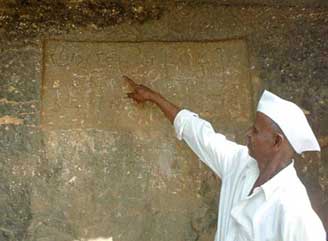 |
|
The old script – Pali – is now no longer understood. |
The raucous or music - depending on the listener’s ear – at the top was heard most of the way up. The sounds of drumming and chanting carried well through the mountain air. We discovered the source as soon as we arrived at the destination of the 2 temples – a group of young men who had apparently already visited the Hindu temple and were celebrating the holy place through song, dance, brightly colored powdered tossed around in joyous craziness, and much laughter – literally dancing themselves silly.
We visited the Buddhist cave temples at both Karla and Bhaja. The Bhaja temple from the 2nd century BC, built by Asoke, the Indian ruler responsible for spreading Buddhism to the far corners of India. The Karla temple was built a century later. Both are sculpted out of the rock face of the mountain, into a cave, with pillars, carvings and a stupa. That is to say, there was a main sanctuary-like area at each temple that led along columns to a large stupa, topped by the traditional umbrella to signify Buddha’s place. The age of the temples was seemingly imprinted there with the old script – Pali – now no longer understood.
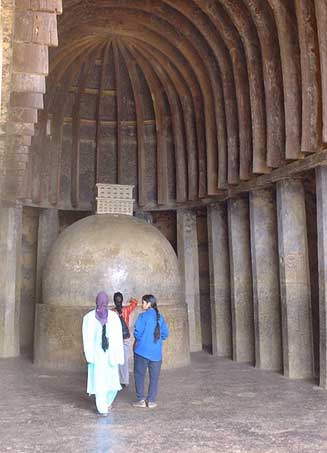 |
|
One young woman worked for 20 minutes to get her coin to stay up there! |
For good luck, you can toss a coin and have it land in the square platform atop the stupa – of course, you need to get the coin in on the first try for the wish to come true, but we watched as one young woman worked for 20 minutes to get her coin to stay up there! In addition, at the Bhaja caves there was a set of 14 additional stupas – each contains a relic of the Buddha, meant to provide as the essence of his being to his followers. We were shown around by an old man who works at the temples at Bhaja; we understood that the relic supposed to be in one of the stupas was a tooth of Buddha when he pointed in the hole of the stupa and then to his toothless grin. Neighboring the main “sanctuary” of each temple were “dormitories” also carved out of the stone, some with a platform for a bed, where the monks would have lived. Each temple sat high above the plateau, with a view to the farming plain below.
 |
|
Their teacher joined in on the jovial interaction. |
Because foreigners were not all that common as visitors to these temples, we seemed to be an object of some interest. Several Indian tourists asked if we would pose with them in their photos. And then of course, we were doing some of that ourselves – taking pictures of the other tourists as part of the scene we were observing. As a result, I had a pretty special encounter with a group of school children visiting the Karla temple. I took a photo of this school group, and showed it to them on my digital camera – they all laughed, and asked for a repeat. I did it again; next their teacher joined in on the jovial interaction – about 4-5 photos later and much laughter, we parted, but we kept running into each other for the rest of the visit to this temple – and I had an entire classroom of school children waving at me, laughing with me, saying goodbye – two of them even tracked me down for one more photo! We also toured for a bit with a group of three Indian men visiting from Chennai (Madras). They were in Bombay on business, and this was there weekend retreat. They also spoke no Hindi, and we talked about the challenges of communicating with the taxi drivers who speak so little English. (Their native language is Tamil, spoken throughout the south of India.)
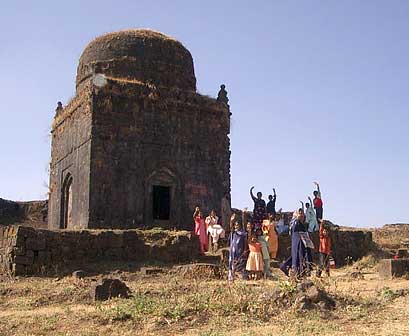 |
|
The family was great – this was not a small nuclear family, American-sized. This was an Indian-style family outing, with aunts, uncles, cousins |
The fort was a pretty special spot. The trail headed through a small village, with a direct path through the farmers’ fields, past buffaloes and small huts, and then up, up, up. For a long way we could see ramparts on a butte – it was only when the trail turned a corner that we realized that the ramparts we were gazing at were for a different fort, not the one we were heading to. Finally we climbed many many steps, to reach a series of four stone gates, greeted by a crew of many monkeys climbing along the walls of the fort. It was not until we passed through fully three of the gates that we fully appreciated our destination –for we suddenly had an enormous vista of two huge lakes that took up a major part of the landscape, rising into other buttes surrounding their edges. We explored the ruins with a group visiting from Bombay.
We are planning other weekend excursions. We must really live here, if coming back to Bombay from a weekend “away” constitutes coming home!
<Home
Lots more pictures of the hills>